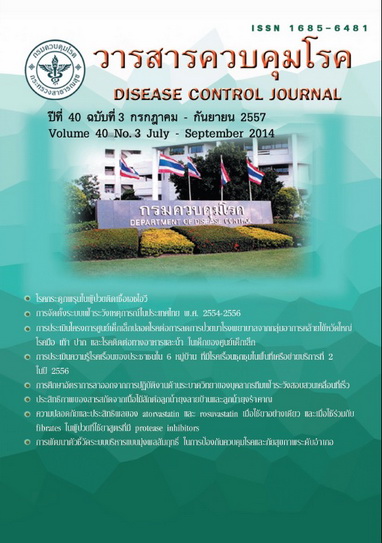Impact of Healthy Nursery Project on Hospital visit for Influenza Like Illness, Hand Foot and Mouth Disease, and Food and Waterborne Diseases in Thailand.
DOI:
https://doi.org/10.14456/dcj.2014.11Keywords:
Healthy Nursery Project, Influenza Like Illness, Hand Foot and Mouth Disease, Food and Waterborne DiseaseAbstract
This observational retrospective cohort study was conducted on 148 nurseries across the country to evaluate the impact of the Healthy Nursery Project and its interventions on hospital visit for Influenza Like Illness (ILI), Hand Foot and Mouth Disease, and Food and Waterborne Diseases. Hospital administrative data were collected to identify infected children and simple logistic regression, using "nursery evaluation score" as a single predictor variable, was conducted to evaluate its impact on diseases. The study revealed that for one "nursery evaluation score" increase, children in the nursery would have 0.90% percent reduction in the odds of developing ILI which require hospital visit (OR = 0.991 (95.00% Cl 0.984-0.998). However, no significant reduction of Hand Foot and Mouth Disease or Food and Waterborne Diseases were observed. Among 35 interventions under Healthy Nursery scheme, proper caregiver-children ratio, proper patient isolation, proper toys cleaning, and sufficient tap water outlet showed significant reduction of hospital visit for ILI with adjusted OR 0.88 (95.00% Cl 0.83-0.95), 0.76 (95.00% Cl 0.67-0.87), 0.86 (95.00% Cl 0.75-0.99) and 0.85 (95.00% Cl 0.76-0.95), respectively. In conclusion, the Healthy Nursery Project and some of its interventions e.g. proper caregiver-children ratio, patient isolation, proper toys cleaning, and sufficient tap water outlet could reduce hospital visit for ILI.
Downloads
References
2. Richard SA, Black RE, Gilman RH, Guerrant RL, Kang G, Lanata CF, et al. Diarrhea in early childhood: short-term association with weight and long-term association with length. Am J Epidemiol 2013;178:1129-38.
3. National Institute of Child Health and Human Development Early Child Care Research Network. Child care and common communicable illnesses: results from the National Institute of Child Health and Human Development Study of Early Child Care. Arch Pediatr Adolesc Med 2001;155:481-8.
4. อาจารี อิงคะวณิช, จงกล พวงนาค. แนวทางการป้องกันควบคุมโรคติดต่อในศูนย์เด็กเล็กและอนุบาล. กรุงเทพมหานคร: ศรีอนันต์การพิมพ์; 2553.
5. สำนักระบาดวิทยา กระทรวงสาธารณสุข. ระบบเฝ้าระวังโรค (รายงาน 506) [อินเทอร์เน็ต]. [สืบค้นเมื่อ 1 ก.พ. 2557]. แหล่งข้อมูล: http://www.boe. moph.go.th/
6. พรศักดิ์ อยู่เจริญ, ธนาวดี ตันติทวีวัฒน์. คู่มือการประเมินศูนย์เด็กเล็กปลอดโรค. กรุงเทพมหานคร: โรงพิมพ์ชุมนุมสหกรณ์การเกษตรแห่งประเทศไทย; 2554.
7. วัชรี สารีบุตร, อาจารี อิงคะวณิช. ผลการดำเนินงานโครงการนำร่องศูนย์เด็กเล็กปลอดโรค. ไม่ได้ตีพิมพ์; 2553.
8. Frydenberg A, Starr M. Hand, Foot and Mouth Disease. Aust Fam Physician 2003;32:594-5.
9. Jiraphongsa C, Bresee JS, Pongsuwanna Y, Kluabwang P, Poonawagul U, Arporntip p, et al. Epidemiology and burden of Rotavirus Diarrhea in Thailand: result of sentinel surveillance. J Infect Dis 2005;192:S87-93.
10. Bernstein DI. Rotavirus overview. Pediatr Infect Dis J 2009;28:S50-3.
11. Adalja AA, Crooke PS, Hotchkiss JR. Influenza Transmission in Preschools: Modulation by contact landscapes and interventions. Math Model Nat Phenom 2010;5:3-14.
12. Pappas DE, Hendley JO, Schwartz RH. Respiratory viral RNA on toys in pediatric office waiting rooms. Pediatr Infect Dis J 2010;29:102- 4.
Downloads
Published
How to Cite
Issue
Section
License
Articles published in the Disease Control Journal are considered as academic work, research or analysis of the personal opinion of the authors, not the opinion of the Thailand Department of Disease Control or editorial team. The authors must be responsible for their articles.






